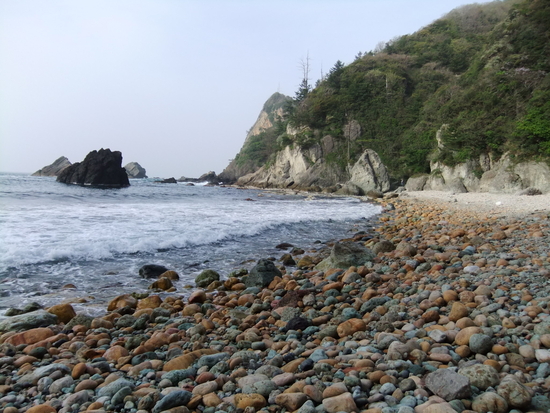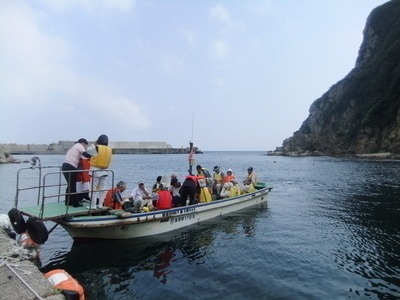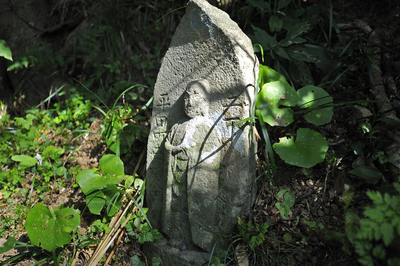Aka-ura
| Bay Name | Aka-ura | |
|---|---|---|
| Shrine Name | (Former) Jizo-son (Present) Unknown |
|
| Deity | Jizo-son | |
| Location |
|

Aka-ura wasn’t included in the Houei 7 (1710) 42 Bay list. The 1863 pilgrimage by Kanezaki Zenbei first introduced a ‘Jizoson’ Buddhist statue between Saka-ura and Koizu. Regarding the Jizoson, the cape to the East of Aka-ura known as Jizobana (hana/bana=cape or tip) In the area on the way from Saka-ura to Aka-ura has a sense of tranquility due to it being the outer precincts of Ichibata Yakushi temple. Although the relationship between Jizoson and Ichibatayakushi and further ‘Jizo’ and ‘ Ichibata Nyourai’ is not immediately apparent, , according to legend, a stone jizo from the Jizoubana forest fell into the sea and was washed up at Taisha machi. Another theory from the origin of Ichibatayakushi is that back in 854, a local man named Yoichi, found a round stone Buddha off the sea of Aka-ura and began to worship it. There is a possibility that this Jizoson is the Ichibata Jizoson.
The Unyoushi mentions a ‘Jizo Waterfall of around 360 feet with a Jizoson in the middle of its caves’. This is quite feasibly the Jizo seen by Kanezaki Zenbei.
Aka –ura is a small bay of only 200 meters but as depicted in its name, the tiny red stones spreading out over the inlet makes it a shoreline of particular scenic beauty.

There are two roads which lead to Aka-ura but the one going from the West side of Saka-ura harbor involving going up a mountain is said to be the easier of the routes.
However, while the guide says it’s only a 1km walk from Saka-ura to Aka-ura, for those who are a little unsteady on their feet, there is a way by boat available, too. Please note, this trip involves going out into the open sea, so it’s vital to keep up to date with the weather conditions on the day.
The road from Saka-ura harbor to Aka-ura is a steep, unpaved road which was once the old path used by pilgrims on their way to the shrines. One can certainly feel its 1100 year-old history.
After the ascent, the view of the Japan Sea on the right is most exhilarating.
In an all stone coastal area like this, the sea can be very rough and the high waves block out all other sounds almost leaving you with a feeling of silence.
A word regarding facilities: Aka-ura does not have any restrooms. There are some in Saka-ura at the fishery cooperative which have been said to be available during the day. Toilets can be found ahead of the Torii gate at Tomosaki-jinja.

| Bay Name | Aka-ura | |
|---|---|---|
| Shrine Name | (Former) Jizo-son (Present) Unknown |
|
| Deity | Jizo-son | |
| Location |
|
Aka-ura wasn’t included in the Houei 7 (1710) 42 Bay list. The 1863 pilgrimage by Kanezaki Zenbei first introduced a ‘Jizoson’ Buddhist statue between Saka-ura and Koizu. Regarding the Jizoson, the cape to the East of Aka-ura known as Jizobana (hana/bana=cape or tip) In the area on the way from Saka-ura to Aka-ura has a sense of tranquility due to it being the outer precincts of Ichibata Yakushi temple. Although the relationship between Jizoson and Ichibatayakushi and further ‘Jizo’ and ‘ Ichibata Nyourai’ is not immediately apparent, , according to legend, a stone jizo from the Jizoubana forest fell into the sea and was washed up at Taisha machi. Another theory from the origin of Ichibatayakushi is that back in 854, a local man named Yoichi, found a round stone Buddha off the sea of Aka-ura and began to worship it. There is a possibility that this Jizoson is the Ichibata Jizoson.
The Unyoushi mentions a ‘Jizo Waterfall of around 360 feet with a Jizoson in the middle of its caves’. This is quite feasibly the Jizo seen by Kanezaki Zenbei.
Aka –ura is a small bay of only 200 meters but as depicted in its name, the tiny red stones spreading out over the inlet makes it a shoreline of particular scenic beauty.
There are two roads which lead to Aka-ura but the one going from the West side of Saka-ura harbor involving going up a mountain is said to be the easier of the routes.
However, while the guide says it’s only a 1km walk from Saka-ura to Aka-ura, for those who are a little unsteady on their feet, there is a way by boat available, too. Please note, this trip involves going out into the open sea, so it’s vital to keep up to date with the weather conditions on the day.
The road from Saka-ura harbor to Aka-ura is a steep, unpaved road which was once the old path used by pilgrims on their way to the shrines. One can certainly feel its 1100 year-old history.
After the ascent, the view of the Japan Sea on the right is most exhilarating.
In an all stone coastal area like this, the sea can be very rough and the high waves block out all other sounds almost leaving you with a feeling of silence.
A word regarding facilities: Aka-ura does not have any restrooms. There are some in Saka-ura at the fishery cooperative which have been said to be available during the day. Toilets can be found ahead of the Torii gate at Tomosaki-jinja.






